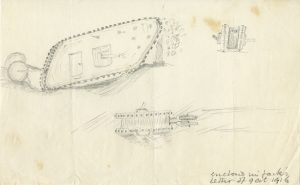Jack followed a pattern when he wrote to his family. He often opened by thanking them for the gifts and letters that they sent and acknowledging the receipt of their letters. He would then proceed to tell them about his current lodgings, the weather, and the routine tasks of his men before closing with a few remarks about the pram and requests for things that he needed. Sometimes, though, Jack breaks his pattern when he has some particularly exciting news from the front. And on 9 October 1916, five months into the Battle of the Somme, Jack ends his letter with the cryptic message:
I enclose a drawing which may convey something to someone.
He seems to have written that line ironically, as he follows this with the cheeky admission:
I have not seen the subject but had it described more or less accurately & am not giving away secrets as the Bosch has seen it.
The drawing that Jack is referencing is a sketch of a tank, a machine that first saw action at the Somme on 15 September 1916.
Jack was clearly interested in this odd bit of technology. He was practical to a fault about writing letters; if he had nothing to say, he told his family that he had nothing to say. If he was too busy to write a long letter, he told his family that he was too busy to write a long letter. But when he got excited about something, Jack would gladly scribble an extra paragraph or two and – in rare cases – send along a sketch like the one above. He would not have spent the time conveying the news of the tank to his family if he were not himself intrigued by the new invention.
In fact, Jack mentions the tanks a few weeks earlier in his letter of 20 September 1916:
I hear the tanks they are using on the Somme were quite a success, though 2 or 3 are now prisoners in the Bosche’s hands & one or two are deranged by being hit by crumps.
The tank was not the only innovation that Jack felt compelled to write home about, either. As early as 6 March 1916, he mentions a trip he made with his C.O. to an exhibition of trench mortars and describes a specific gun that piqued his interest:
There was a new gun there which struck me as being very useful – in fact it fires so fast that you can get 5 rounds in the air with it at once & another French gun, which is very portable & should be very useful.
The next month, on 24 April 1916, he happily relays information home about airplanes:
Another fine day & the aeroplanes are buzzing about in swarms. I fancy we have got some new aircraft guns here, as we got 2 of the Bosch planes for certain this morning & they say here that 3 were seen to fall & another one yesterday we brought down in their lines.
From time to time, Jack even likes to add some analysis of his own about these technological advancements. He writes in his letter of 13 October 1916 that he and his men are stationed along a row of old trenches that had seen use very early on in the war, back in 1915. He says:
It is quite evident that there was nothing like the shell fire then that there is now & trench mortars must have been more or less non existent, whereas now they are what the commonest form of explosive in the trenches.
Jack observes that these trenches, despite having been under fire in 1915, do not look as worn and damaged as he imagines they would if they had been used in battle throughout 1916. He proposes as the reason for this the innovations that have occurred in trench warfare since the early days of the war, citing the use and development of trench mortars as an example.
It is interesting that Jack made little notes so often about the war’s progression technologically. Clearly, he considered these details important enough to relate to his family. We could speculate as to the reasons why. It is possible that Jack had an inkling that these changes were not just important to the military, but more broadly to European culture as a whole. It is also possible that he felt that these changes were occurring more rapidly than ever before and thus merited a mention in his letters. Maybe he simply thought that he needed something new to write home about, and, as a lover of all things mechanical, he decided to write about tanks and planes and guns.
We cannot know for sure exactly why Jack included these observations of technological advancements in his letters as frequently as he did. If nothing else, we know that he was at least intentionally taking note of the changes occurring around him. Jack’s letters do not reflect complete stagnation on the front. And this conclusion, as simple as it is, tells us something about the First World War itself: despite the stagnation that is often considered characteristic of trench warfare, active changes and innovations were occurring along the front daily. This is an important reminder that soldiers and generals of the First World War were participants, and not victims, of history.

